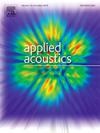Acoustic observations of a prescribed burn
IF 3.4
2区 物理与天体物理
Q1 ACOUSTICS
引用次数: 0
Abstract
Audible sound is known to originate from wildland fires. We show audible sound is accompanied by infrasound emissions, originating from the active combustion zone in a prescribed fire. We collected data from one of multiple prescribed burns conducted at Eglin Airforce Base, Florida in March of 2023. Single-unit infrasonic sensors and a six-element array were deployed outside the burn unit to capture acoustic signals. The array was configured as a hexagon with aperture of ∼10 m. Dual-band radiometers were deployed inside the unit to track the fire’s evolution. A broadband signal is observed by all infrasound sensors with variable intensity and frequency content between 2 Hz and up to 90 Hz. The sensor closest to the perimeter of the unit detected frequencies up to 90 Hz for a few minutes. Array analysis shows a coherent broadband signal with frequencies between 2 and 40 Hz emanating from the burn unit that we argue is sound from the active combustion zone. The estimated azimuths follow the ignition pattern with delays of several minutes between the ignition and detection of sound. We discuss the potential for using acoustic measurements to study the spatial and temporal evolution of fire and extract spectral features of vegetation type-specific heat release rates. Extracting fire characteristics and dynamics using sound may complement other more established measurements by providing continuous data remotely that are not constrained to line-of-sight or visibility conditions that can be affected by smoke or topography.
求助全文
约1分钟内获得全文
求助全文
来源期刊

Applied Acoustics
物理-声学
CiteScore
7.40
自引率
11.80%
发文量
618
审稿时长
7.5 months
期刊介绍:
Since its launch in 1968, Applied Acoustics has been publishing high quality research papers providing state-of-the-art coverage of research findings for engineers and scientists involved in applications of acoustics in the widest sense.
Applied Acoustics looks not only at recent developments in the understanding of acoustics but also at ways of exploiting that understanding. The Journal aims to encourage the exchange of practical experience through publication and in so doing creates a fund of technological information that can be used for solving related problems. The presentation of information in graphical or tabular form is especially encouraged. If a report of a mathematical development is a necessary part of a paper it is important to ensure that it is there only as an integral part of a practical solution to a problem and is supported by data. Applied Acoustics encourages the exchange of practical experience in the following ways: • Complete Papers • Short Technical Notes • Review Articles; and thereby provides a wealth of technological information that can be used to solve related problems.
Manuscripts that address all fields of applications of acoustics ranging from medicine and NDT to the environment and buildings are welcome.
 求助内容:
求助内容: 应助结果提醒方式:
应助结果提醒方式:


